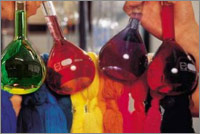Have you ever wondered what gives the cloths your the jazzy
colours, what gives the printer you use with your desktop the
multicoloured printing. The answer to all this lies in the synthetic
dyes. No doubt Synthetic dyes today has evolved into a multi billion
dollar industry. Almost all the colours that you see today are Synthetic
dyes. They are widely used for dyeing and printing in a broad range of
industries. There are over 10,000 dyes, and the annual production
globally, exceeds over 7 × 105 metric tones. They have become
indispensable to the dyeing units specifically to textile units. It is a
fact that fashion would not have so much vibrancy in terms of colours
and generated so much hype and enthusiasm, were it not for the synthetic
dyes. The synthetic dyes, can be named according to the chemical
structure of their particular chromophoric group. For example,
diphenylmethane derivatives, triphenylmethane compounds oxazine
compounds, xanthene compounds, Azo dyes to name a few. Out of these Azo
Dyes are one of the most popular varieties of synthetic dyes. Today it
is being used up to 90% in the dyeing units, as they are versatile and
simple to synthesize. Most of the synthetic dyes with a few exception
are aromatic organic compounds which can be divided into groups like
non-ionic (oil soluble), cationic, and anionic. A typical example of
Cationic dye is Methyl violet, while Azo dyes are anionic dyes.

Synthetic dyes can be primarily made from aniline or chrome. Aniline
dyes are obtained from chemical processes and is defined as a class of
synthetic, organic dyes. Today the term dye is almost synonymous with
any reference of synthetic organic dye or pigment. Aniline dyes are
classified based on their degree of brightness or according to light
fastness. They are also called coal tar dyes, because the synthetic
aniline dyes were made up of coal tar initially, but they faded easily
when exposed to sun light. While Chrome dyes were color fast and
non-corrosive.
Since textile units are predominant consumers of most
of the synthetic dyes, so it would be worthwhile here to mention the
types of synthetic dyes that are available for use in the textile dyeing
process.
The following parameters can serve as a guideline for
synthetic dyes:-
- Fading
- Machine wash ability
- Boiling
- Perspiration
- Dry cleaning
- Hot pressing
- Steam pressing
- Salt water
- Gas fume fading (from oil heaters)
- Fastness assessments
Although the synthetic dye production when it came
into being was basically for serving the textile industry but many
subsequent applications later on has been developed. Today synthetic
dyes are used in a multitude of industries that includes the following
besides textiles. Medicine, chemistry, and other related fields.
Commercial products like plastics, paint, printing ink, rubber,
cosmetics etc.
 Synthetic dyes can be primarily made from aniline or chrome. Aniline
dyes are obtained from chemical processes and is defined as a class of
synthetic, organic dyes. Today the term dye is almost synonymous with
any reference of synthetic organic dye or pigment. Aniline dyes are
classified based on their degree of brightness or according to light
fastness. They are also called coal tar dyes, because the synthetic
aniline dyes were made up of coal tar initially, but they faded easily
when exposed to sun light. While Chrome dyes were color fast and
non-corrosive.
Synthetic dyes can be primarily made from aniline or chrome. Aniline
dyes are obtained from chemical processes and is defined as a class of
synthetic, organic dyes. Today the term dye is almost synonymous with
any reference of synthetic organic dye or pigment. Aniline dyes are
classified based on their degree of brightness or according to light
fastness. They are also called coal tar dyes, because the synthetic
aniline dyes were made up of coal tar initially, but they faded easily
when exposed to sun light. While Chrome dyes were color fast and
non-corrosive. 